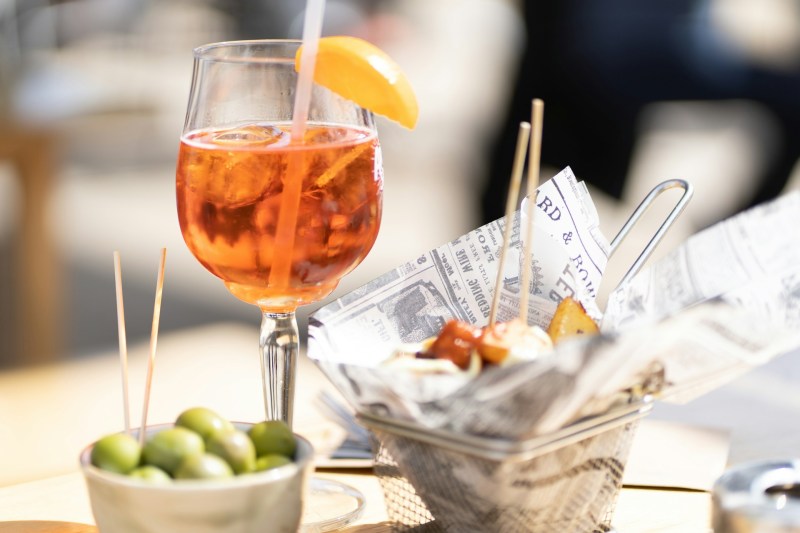If you’re an avid cocktail fan, you’ve probably enjoyed a before-dinner Aperol Spritz before during the sweltering summer months. This simple, elegant, refreshing drink consists of Prosecco (Italian sparkling wine), soda water, and Aperol.
If you’ve never tried this aperitif, you’ve likely at least heard of Aperol or at the very least have seen the world written on a cocktail menu. There’s also a chance that you have no idea what Aperol is and never thought about it before. That’s okay. We’re here to help.
What is Aperol?

If you’ve ever seen a bottle of Aperol, you might have noticed its unique appearance. Aperol is well-known for its bright orange hue. But if you think you’re going to pour it into a glass and your taste buds will be met with a sweet, sugary, orange-flavored liqueur, you are sadly mistaken. While there is orange flavor in there, like Campari, Aperol is a bittersweet Italian liqueur.
Flavored with a blend of roots, fruits, flowers, herbs, and botanicals, it’s best known for its flavors of gentian root, rhubarb, cinchona, orange peel, and various citrus oils. Referred to as an amaro (also known as a bitter Italian liqueur like Campari, Averna, and others), this spirit was created to be enjoyed before a heavy meal to help stimulate your appetite.
With a lower alcohol content than many liqueurs (at 11% ABV), it’s a semisweet, citrusy, spiced ingredient coveted by bartenders and drinks alike.
What is its history?

Brothers Luigi and Silvio Barbieri spent more than seven years macerating and experimenting with various roots, botanicals, fruits, and spices at the family’s Padua, Italy-based distilled before they came up with the recipe for Aperol in 1919. In the following decade, the amaro became very popular throughout Italy. Its popularity exploded when the Aperol Spritz was invented in the 1950s.
The brand was steadily popular in Italy for the next half-century. But like with many classic mixed drinks, the cocktail renaissance brought the drink to the mainstream as it became a go-to before-dinner drink in Italy, the US, and throughout the world. Today, Aperol is arguably at its most popular level to date.
What does Aperol taste like?

When it comes to bittersweet Italian bitter liqueurs, Aperol leans more toward the sweet side. The bitterness is there, but it’s tempered by a sweet, vanilla-like sugary hit. You’ll also find flavors of candied orange peels, gentle spices, roots, and an enveloping herbal quality. It’s the kind of liqueur that requires multiple samplings to unlock all the flavors. It’s also well-known for being a spirit that tastes slightly different to everyone.
How should you drink it?

There are many ways to imbibe Aperol. If you enjoy bittersweet amaro, you can drink Aperol neat or on the rocks. But most drinkers enjoy it as an ingredient in a variety of cocktails including the aforementioned Aperol Spritz. It’s best when it’s used to complement another flavor as opposed to on its own. Whether or not you drink it neat or in a cocktail, due to its mix of roots, herbs, citrus, and other fruits, it’s best enjoyed as a way to prepare your stomach for a heavy, savory, rich meal.
Aperol versus Campari

If you’re new to Italian bitter liqueurs, you might assume Aperol and Campari are the same thing. They aren’t. Sure, they are both reddish-orange in color and both are owned by the same brand, but Campari was created sixty years earlier than Aperol in Milan.
Both bitter liqueurs have spiced orange-centric flavor profiles, but Aperol is much sweeter with a much higher sugar content while Campari is much more bitter with much less sugar included. Also, while Aperol is low in alcohol content at only 11% ABV, Campari is more than double that with 24% ABV.
Bottom line

While you might stock your home bar with bottles of vodka, gin, tequila, rum, and various types of whiskey as well as bitters and other ingredients, you might not think a bottle like Aperol (or Campari) is important. It absolutely is.
It’s a great bottle to have on hand for a summery, refreshing Aperol Spritz alone, but you will also use it in a wide variety of cocktails. This includes the Paper Plane, Naked and Famous, and more. It’s also a great bottle to have in your home bar for experimenting with flavors. If you enjoy slightly bittersweet flavors, add them to your favorite cocktails to elevate them. Who wouldn’t want to turn a boring Old Fashioned or Gin & Tonic up to eleven? We know we would.




